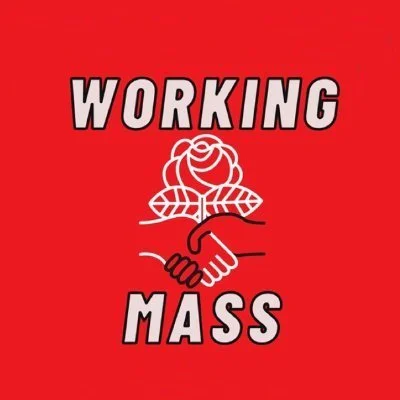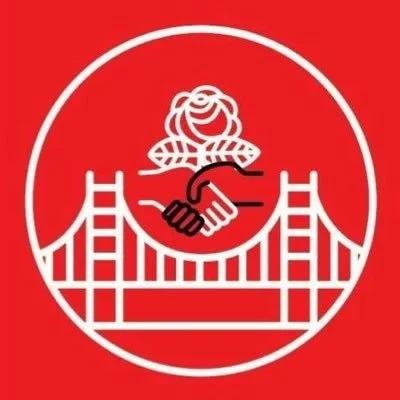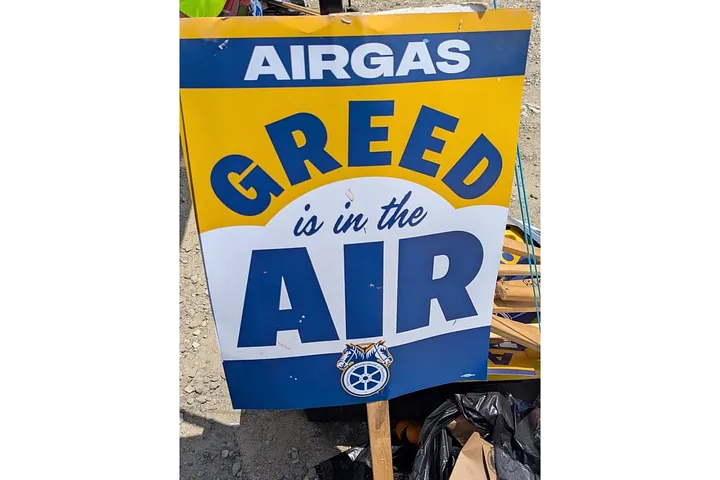
DSA Feed
This is a feed aggregator that collects news and updates from DSA chapters, national working groups and committees, and our publications all in one convenient place. Updated at 9:30 AM ET / 6:30 AM PT every morning.


Sanitation Workers Strike for Fair Compensation Against Waste Disposal Giant
By: Nate Foster

PEABODY, MA – Over 400 sanitation workers across Massachusetts went on strike on Tuesday, July 2, amidst contract disputes with the waste disposal corporation Republic Services.
The workers are represented by Teamsters Local 25. The union statement on the strike has called out Republic for refusing to concede competitive wages and benefits to their employees. Republic, the second largest waste company in the U.S., now faces a work stoppage that has already affected waste collection in 14 cities and towns in the North Shore area.
The Teamsters warned of potential nationwide strikes as over 3,500 sanitation workers across the country face similar negotiating difficulties with Republic; the strike expanded on Wednesday, July 3, to include workers of Teamsters Local 179 in Ottawa, Illinois. Sanitation workers in other unions across the sector are similarly embroiled in strike battles across the United States. In Philadelphia, 9000 municipal workers — including sanitation — organized with AFSCME DC33 went on strike on July 1.
Republic has called the strike “disappointing.” The company claims to already provide fair compensation and benefits. This opinion was not shared by the workers, the union, or experienced labor organizers such as Beth Kontos, Vice President of the North Shore Labor Council:
I know health insurance is part of the problem. I’ve been told that [the workers] make on average five dollars less per hour than people in the same industry in surrounding towns. [Republic Services] is not going to be able to hold talent… you’ve got to pay people to stay, you know.
In response to the work stoppage, Republic has brought in replacement workers, or scabs, to carry out a limited collection schedule while pressure and curbside trash mounts on the company for an agreement. Many picketing in Peabody on Wednesday, July 3, expressed doubt in the ability of the scabs to make up for the absence of over 400 unionized laborers of the Republic workforce, especially given the possibility of additional strikes breaking out in other areas, should corporate negotiation efforts continue to fall short of workers’ expectations.
Affected towns and cities have created alternate waste drop-off points to accommodate residents’ needs during the strike. These present hurdles for people without cars, those with physical disabilities, or anyone with a packed schedule during a massive American holiday weekend, direct impacts of Republic Services’ refusal to meet the union’s demands.

As trash piles up in the July heat and North Shore towns scramble for solutions, the immediacy of the strike’s impact after just two days makes the essential nature of sanitation work blisteringly clear. When such important labor is taken for granted, the resulting consequences are felt not just in Republic boardrooms, but among the Massachusetts public as a whole. Making sure that workers are appropriately compensated in a North Shore area with serious affordability concerns is going to benefit a lot more people than the RSG listing being higher on the New York Stock Exchange.
Kontos urged those affected by the strike to help towards a fair agreement between the Teamsters workers and Republic by calling elected representatives to drum up solidarity, as well as coming in-person to the picket lines.
Anybody that lives in the cities that are affected by this, and anybody who cares about public health and safety, they need to call their city councilors, their mayors, and their state representatives and senator and ask them to call and put pressure on this [issue]… and anybody who wants to should show up here in person; if your trash is not getting picked up, you need to come walk this line with us.
The workers, the union members, and the solidarity of local labor organizers has put Republic Services between a rock and a hard place. It is pivotal for people in Massachusetts to support the strike, and those who do essential work in their communities, so that crucial social services aren’t undermined by the interests of a few shareholders. Collective action is what will yield collective results.
Nate Foster is a member of Boston DSA and contributing writer to Working Mass.

The post Sanitation Workers Strike for Fair Compensation Against Waste Disposal Giant appeared first on Working Mass.


Time is short, act now! Tell you reps to pressure their Republican colleagues to vote NO!
Slightly different versions of the “Big Beautiful Bill” have passed in the House and Senate. Wildly unpopular among the American people, this bill has barely squeaked through Congress. Passing in both the House and Senate by only 1 vote. Now, it goes back to the House. Trump is calling for it to be on his desk for July 4th.
Time is short, act now! Use the form below to tell you reps to pressure their Republican colleagues to vote NO!
NO cuts to SNAP and Medicaid!
NO funding for ICE abductions!
NO handouts for billionaires!
Cuts to vital services are dwarfed by the handouts to billionaires. The “Big Beautiful Bill” would be one of the largest cash grabs by billionaires in world history.
ICE has terrorized communities by abducting people off the street. Masked men have grabbed people off the street and put them in unmarked vehicles. Holding them without charges, deporting them without due process. The “Big Beautiful Bill” will reinvigorate an agency that kidnaps our neighbors.
The “Big Beautiful Bill” makes massive cuts to vital programs. More than 40 million Americans will lose vital help putting food on the table. As many as 17 million poor and disabled Americans will lose their healthcare. Cuts to rural hospitals and nursing homes will leave many without access to medical care.
Many will go hungry and many will die because of this bill. Tell your representatives to use all their power to stop this Big Bullshit Bill!
The post Time is short, act now! Tell you reps to pressure their Republican colleagues to vote NO! appeared first on Grand Rapids Democratic Socialists of America.


No Staff Too Small to Strike
Author: Kevin N.
Teamsters workers at the Airgas plant in Valley View, Ohio, are on strike as of June 25th. After voting 13 to 5 in favor of forming a union a little more than a year ago, the location’s 23 workers still don’t have a contract. Large corporations, like Airgas, are known to stall negotiations with newly formed unions for as long as financially possible. What is surprising is the Valley View location is not negotiating the first contract between Airgas and Teamsters, and another Airgas facility less than ten miles away got their contract months ago. However, another Ohio Airgas location just a few miles from the Valley View plant already negotiated their union contract months ago.
“In a nutshell, our sister plant in Oakwood is about 5 or 6 miles down the road. They just got a contract last year,” explains Joe Most, one of the Valley View union’s chief organizers. “That’s a good, fair contract, which that’s all we want. We’re not asking for anything more than them.” Among other benefits and stipulations sought by the Valley View union, the Oakwood contract includes a modest raise of an additional $2 per hour for each of the plant’s 23 employees.
Regardless of the Oakwood plant’s within-walking-distance precedent, Airgas is still refusing to negotiate. According to Most, the legal team that negotiated and signed the Oakwood contract was fired by Airgas after doing so, and the new legal team has been far from cooperative with the union at Valley View plant.
Among the conditions that Airgas was trying to include in the contract was a provision that would allow Airgas to make medical determinations in the case of emergencies. “If you got hurt on the job, [the company would decide] whether you go to the hospital and whether to provide transport.” Most says that this controversial provision, among others, caused negotiations to unravel, so the Teamsters declared on June 25th that they will strike until the Valley View Airgas workers are given fair treatment.
Joe Most says that he was initially skeptical when his coworker approached him about asking the Teamsters to help their small plant unionize. At a previous job, Most was a member of a UAW union, and he was disappointed by the lack of support his plant received. “Because we were only 150 [workers at that location], they [UAW] practically ignored us because we were so small.” Most recalls that when they approached UAW about supporting them during a strike, the union’s leaders declined to do so, claiming that the plant’s small size made it “not worth it.” (Most also notes that his experience with UAW was more than 20 years ago, and suggests that their practices may have changed since then.)
In contrast, the Teamsters have agreed to support the far smaller Valley View Airgas location, despite having a staff less than one sixth the size of Most’s previous job where the union was UAW. Most said he’s been “shocked” by the level of support they’ve received. When the plant was initially fighting for the contract, Juan Campos, the Vice President of the Teamsters, came to the Valley View plant to personally oversee the negotiations. “When they told me the vice president was coming in from Chicago, I thought, ‘I mean, he’s going to ‘big-time’ us, right? There’s no way he’s going to talk to these peons,’ you know?” laughs Most. “But no, he went to each person, shook their hand, asked them, ‘Do you have any questions?’ and gave them his card.”
What’s more, when it became clear during the contract negotiations that the Airgas representatives were refusing to match the Oakwood plant’s contract, it was Campos himself who walked out of negotiations and declared that the tiny plant of 23 workers would strike with the full support of the Teamsters. That is what working class solidarity looks like.
The Teamsters are coordinating an escalating strike strategy across the country, which Most estimates could continue for a month. Airgas has tentatively agreed to return to the bargaining table on July 22nd. So far, Airgas plants in Boston, Erie, Pittsburgh, and others have gone on strike, with Teamsters drivers refusing to deliver any goods to those facilities. Further locations are slated to strike next week. “About 20 to 25 [locations] across the Midwest are setting up picket lines,” Most explains, mentioning locations in Minnesota, Wisconsin, Indiana, Illinois, and Missouri, among others. “And it’s not just going to be our guys from my place. If you noticed, we have some retirees and some of the trustees from the Teamsters here [on the picket line] with us.”
When asked about his personal reason for striking, Most explains, “I’m single. I’m basically fighting for the other people with wives and kids. Plus, I think our warehouse workers are underpaid big time for what they do. It’s hot, it’s laborious, I feel bad for them every day when I see them everyday. And I know how much they make.”
Most is confident that the strike will pay off. “If you think you can’t afford the strike, I would say the opposite. You can’t afford not to strike,” he declares. “This is your only way to nail the company. Especially an insanely profitable one like that one. It’s not like they’re filing for Chapter 11 [bankruptcy]. They’re a publicly traded company, so we can see their books.”
Joe Most is no stranger to the union fight. Despite his disappointment with his UAW experience twenty years ago, he acknowledges that it was far better than having no union at all. Most says after joining the UAW union, “I [had been] written up only one time in nine years, and all of a sudden I get fired six times in two years? It was obvious they were retaliating against me,” he recalls.
“But the union was there and I got reinstated with back pay and everything. Every single time.”
The post No Staff Too Small to Strike appeared first on Democratic Socialists of America.


Weekly Roundup: July 1, 2025
Events & Actions
 Tuesday, July 1 (6:00 p.m. – 7:00 p.m.): Ecosocialist Bi-Weekly Meeting (Zoom)
Tuesday, July 1 (6:00 p.m. – 7:00 p.m.): Ecosocialist Bi-Weekly Meeting (Zoom)
 Tuesday, July 1 (7:00 p.m. – 9:00 p.m.): Reading Group: The Housing Question by Friederich Engels (Part 1 of 2) (In person at 1916 McAllister)
Tuesday, July 1 (7:00 p.m. – 9:00 p.m.): Reading Group: The Housing Question by Friederich Engels (Part 1 of 2) (In person at 1916 McAllister)
 Wednesday, July 2 (6:30 p.m. – 9:00 p.m.):
Wednesday, July 2 (6:30 p.m. – 9:00 p.m.):  New Member Happy Hour (In person at Zeitgeist, 199 Valencia)
New Member Happy Hour (In person at Zeitgeist, 199 Valencia)
 Thursday, July 3 (5:30 p.m. – 6:30 p.m.): Education Board Open Meeting (Zoom)
Thursday, July 3 (5:30 p.m. – 6:30 p.m.): Education Board Open Meeting (Zoom)
 Thursday, July 3 (5:50 p.m. – 7:30 p.m.): Socialist in Office + Electoral Board Meeting (Zoom)
Thursday, July 3 (5:50 p.m. – 7:30 p.m.): Socialist in Office + Electoral Board Meeting (Zoom)
 Saturday, July 5 (11:00 a.m. – 1:00 p.m.):
Saturday, July 5 (11:00 a.m. – 1:00 p.m.):  No Appetite for Apartheid Consumer Pledge Canvass (Meet at Harry Bridges Plaza)
No Appetite for Apartheid Consumer Pledge Canvass (Meet at Harry Bridges Plaza)
 Saturday, July 5 (12:45 p.m. – 4:00 p.m.):
Saturday, July 5 (12:45 p.m. – 4:00 p.m.):  Homelessness Working Group Outreach and Outreach Training (Meet at 1916 McAllister)
Homelessness Working Group Outreach and Outreach Training (Meet at 1916 McAllister)
 Saturday, July 5 (1:30 p.m. – 2:30 p.m.): Emergency Workplace Organizing Committee Training: Planning Sync (In person at 1916 McAllister)
Saturday, July 5 (1:30 p.m. – 2:30 p.m.): Emergency Workplace Organizing Committee Training: Planning Sync (In person at 1916 McAllister)
 Saturday, July 5 (2:00 p.m. – 4:00 p.m.): Phonebank to Stop the Billionaire’s Budget Attack on the Unhoused (In person at 1916 McAllister)
Saturday, July 5 (2:00 p.m. – 4:00 p.m.): Phonebank to Stop the Billionaire’s Budget Attack on the Unhoused (In person at 1916 McAllister)
 Sunday, July 6 (5:00 p.m. – 7:00 p.m.): Capital Reading Group (Zoom & in person at 1916 McAllister)
Sunday, July 6 (5:00 p.m. – 7:00 p.m.): Capital Reading Group (Zoom & in person at 1916 McAllister)
 Sunday, July 6 (10:30 p.m. – 1:30 a.m.):
Sunday, July 6 (10:30 p.m. – 1:30 a.m.):  Screening of The Room at the Balboa Theater (In person at Balboa Theatre, 3630 Balboa)
Screening of The Room at the Balboa Theater (In person at Balboa Theatre, 3630 Balboa)
 Monday, July 7 (6:30 p.m. – 8:00 p.m.): Homelessness Working Group Regular Meeting (Zoom & in person at 1916 McAllister)
Monday, July 7 (6:30 p.m. – 8:00 p.m.): Homelessness Working Group Regular Meeting (Zoom & in person at 1916 McAllister)
 Monday, July 7 (7:00 p.m. – 8:00 p.m.): Labor Board Meeting (Zoom)
Monday, July 7 (7:00 p.m. – 8:00 p.m.): Labor Board Meeting (Zoom)
 Wednesday, July 9 (6:45 p.m. – 9:00 p.m.):
Wednesday, July 9 (6:45 p.m. – 9:00 p.m.):  July General Meeting (Zoom)
July General Meeting (Zoom)
 Thursday, July 10 (7:00 p.m. – 8:00 p.m.): Immigrant Justice Working Group Meeting (Zoom)
Thursday, July 10 (7:00 p.m. – 8:00 p.m.): Immigrant Justice Working Group Meeting (Zoom)
 Friday, July 11 (7:30 p.m. – 9:00 p.m.):
Friday, July 11 (7:30 p.m. – 9:00 p.m.):  Comrade Karaoke (In person at The Roar Shack, 34 7th St)
Comrade Karaoke (In person at The Roar Shack, 34 7th St)
 Sunday, July 13 (11:00 a.m. – 1:00 p.m.):
Sunday, July 13 (11:00 a.m. – 1:00 p.m.):  Physical Education + Self Defense Training (In person at William McKinley Monument, Panhandle Park)
Physical Education + Self Defense Training (In person at William McKinley Monument, Panhandle Park)
 Monday, July 14 (6:00 p.m. – 8:00 p.m.):
Monday, July 14 (6:00 p.m. – 8:00 p.m.):  Tenderloin Healing Circle (In person at Kelly Cullen Community, 220 Golden Gate)
Tenderloin Healing Circle (In person at Kelly Cullen Community, 220 Golden Gate)
Check out https://dsasf.org/events for more events and updates. Events with a  are especially new-member-friendly!
are especially new-member-friendly!

Reading Group: “The Housing Question” by Friedrich Engels
Join us in reading the seminal text on the political economy of housing. Written in 1872, “The Housing Question” is Friedrich Engels’ critique of the housing market and the solutions promoted by his contemporaries. 150 years later, his work resonates just as much, if not more, with tenants’ current struggles.
This two-part series will have readers discuss the various historical attitudes and debates around housing and apply those lessons to our modern housing crisis.
Join us for session 1 at the DSA SF office at 1916 McAllister St. on July 1st at 7:00 p.m. A full PDF of the book can be found here.

Summer Social(ist) Events! 
Mark your calendars for our Summer Social(ist) event series!
- July 6th @ 11:00 p.m. – Screening of The Room at the Balboa Theater! We’ll meet outside at 10:30.
- July 11th @ 7:30PM – Comrade Karaoke at the Roar Shack (34 7th Street) – Come hang out and do some FREE karaoke with your fellow DSA SF comrades or cool people you want to impress with your incredible singing voice! No songs refused, no entry denied! Suggested Donation: $10. Drinks: Wine + Beer Available / BYOB
- July 27th @ 1:05PM – Oakland Ballers vs Northern Colorado Owlz baseball game + “Halloween in July Night” (at Raimondi Park) – RSVP here by July 13th so that we can put in a group order of tickets! Group tickets are are $15 per ticket, but no one will be turned away for lack of funds!

 Apartheid-Free Bay Area Consumer Pledge Canvassing
Apartheid-Free Bay Area Consumer Pledge Canvassing
Help build public support for stores that have pledged to go apartheid-free  at the Ferry Plaza Farmer’s Market, Harry Bridges Plaza, this Saturday, July 5 from 11:00 a.m to 1:00 p.m.! You will receive basic training, and then you will put that training into practice by collecting signatures at the Ferry Plaza Building Farmer’s Market. Please sign up here. Bring a tote bag and make sure to wear your DSA merch. New members encouraged to join!
at the Ferry Plaza Farmer’s Market, Harry Bridges Plaza, this Saturday, July 5 from 11:00 a.m to 1:00 p.m.! You will receive basic training, and then you will put that training into practice by collecting signatures at the Ferry Plaza Building Farmer’s Market. Please sign up here. Bring a tote bag and make sure to wear your DSA merch. New members encouraged to join!

Oppose the billionaire budget
Call your comrades to oppose the billionaire budget! Join the DSA SF Electoral Board this Saturday, July 5, 2:00 p.m. to – 4:00 p.m at 1916 McAllister to phonebank members and urge them to send letters opposing Mayor Daniel Lurie’s Billionaire Budget. The proposed budget forces austerity upon the most vulnerable San Franciscans by redirecting Prop C Our City Our Home funds away from effective solutions to homelessness to temporary measures which do not address the root causes of homelessness.
EWOC: How to Talk About Organizing
EWOC (Emergency Workplace Organizing Committee) is a project of the United Electrical, Radio and Machine Workers of America (UE) and DSA working to build a distributed grassroots organizing program to support workers organizing at the workplace. To learn more about the work EWOC does, come by the DSA SF office to pick up a copy of Unite and Win or tune into the Labor Board’s weekly meetings every Monday at 7 p.m. on Zoom.
The next EWOC event hosted by DSA SF features EWOC staff members conducting a training on generating workplace leads and conducting organizing conversations on July 16th from 6:30 p.m to 8:30 p.m. Let us know if you can make it! Hope to see you there!

 Support the Blue Bottle Independent Union
Support the Blue Bottle Independent Union
Nestlé is one of the biggest corporations in the world charged with decades of human rights violations in the global south. They’re now in our backyard intimidating baristas with surveillance, firing, and bad-faith bargaining. Last week, baristas in four Bay Area locations of Nestlé-owned Blue Bottle presented management with a super majority of union cards and demanded voluntary recognition. Instead, Blue Bottle fired one of the organizers, B.B. Young. This comes at an especially bad time for B.B. since their husband was also recently laid off.
Blue Bottle workers are asking for our support
- Donate at this GoFundMe page
- Sign the petition to demand that the company voluntarily recognize the Blue Bottle Independent Union
- Join the Blue Bottle Independent Union email list or follow on Instagram to stay in touch
- If you are an employee of Blue Bottle, fill out this intake form to get involved with organizing the union at your own store
Social Housing Reading Group
What could social housing look like in San Francisco, and how do we get there? Join DSASF for a reading of the Budget and Legislative Analyst’s report on how the city can build its own publicly owned, deeply affordable housing. We will also read the SF Berniecrats report, Housing for the 99%, which lays out a vision for social housing for all in San Francisco. Join us at 1916 McAllister Tuesday, July 22 from 7:00 p.m. to 8:00 p.m.
Reports
Physical Education Training
On June 28th, DSA SF held its first physical education training. Five comrades got together in the park to learn and practice basic movement and self defense skills like falling, squatting, lifting, and palm striking. The next one will be held on July 13th at 11:00 a.m. – 1:00 p.m. at the William McKinley Monument in Panhandle Park. Join us for some fun and inclusive physical education, aimed at building the strength and flexibility to build a better world.

Ecosocialist Office Gardening
The Ecosocialist Working Group held their first office gardening event last Tuesday, with 12 attendees, including 5 non-members. We discussed native plants in the bay area and the various tools to help with plant identification, and labeled our garden with popsicle sticks. Our comrade Lizzie even brought a microscope to take a closer look at petals and leaves.
Stay tuned for the next office gardening event! To get involved, join #ecosocialism on the DSA SF Slack, or reach out to ecosocialist@dsasf.org.
Behind the Scenes
The Chapter Coordination Committee (CCC) regularly rotates duties among chapter members. This allows us to train new members in key duties that help keep the chapter running like organizing chapter meetings, keeping records updated, office cleanup, updating the DSA SF website and newsletter, etc. Members can view current CCC rotations.
To help with the day-to-day tasks that keep the chapter running, fill out the CCC help form.


Rochester Red Star | July 2025 | (Issue 15)
Monthly Newsletter of the Rochester Chapter of Democratic Socialists of America
Welcome to the July issue. You’ll find Upcoming Events, coverage of chapter activities, and articles on the Democratic primary elections, capitalism’s death toll, podcast recommendations, community gardening, and more. Want to contribute? Submit to bit.ly/SubmitRedStar, or reach out to get involved with our Communications Committee by emailing steering@rocdsa.org.
The post Rochester Red Star | July 2025 | (Issue 15) first appeared on Rochester Red Star.


Airgas Teamsters on Strike in Ferndale: Greed Is in the Air
By: Collin P.

DSAers will be visiting the picket line in numbers on Tuesday, July 1 at 6pm, at 800 Farrow in Ferndale. Show your solidarity!
Our world runs on pressurized gas. I’m not talking about gasoline. I’m talking about acetylene for welding your cars together, propane for heating homes, nitrogen for fire suppression systems, and oxygen for hospitals. These gases are supplied by workers at companies like Airgas. These are the workers who fill the canisters, ensure gases are safely stored and stable, and transport them to where they need to be. And these are the same 30 Teamsters Local 283 workers who are now on strike for their dignity and livelihood.
The strike began June 23 after months without a contract. The workers had been trying to negotiate with management since November 2024 and the next session isn’t even scheduled for two weeks. Eleven Airgas units are now on strike across the country with more to come!
Workers’ Demands
I stood at the picket line in solidarity last Wednesday, Thursday, and Friday with workers like John, a truck driver who has been at Airgas for eight years. He loves being on the road and getting people the oxygen they need. What he doesn’t love is the poor wages and poor raises, neither of which are sustainable.
He also doesn’t love management’s introduction of driver-facing cameras; he is on camera at all times during the day. Management has been abusing these cameras to ding their workers for minor infractions, including drinking water, to slowly chip away at their dignity or even their livelihood.
Ray has been with Airgas for seven years. He used to be a union sheet metal worker, working in facilities where they built paint booths for the Big 3 automotive. He loved that job, talking of the brotherhood and solidarity he felt. He had to leave due to health conditions, but with his CDL and hazmat certifications, he found a new position driving for Airgas and loved it.
That was until new management added the driver-facing cameras and forced him out of the trucks and into the warehouse. He now unloads and loads every truck that comes into the facility as opposed to being on the open road where he would rather be.
Both John and Ray said that a new HR lead quickly started wrongly dinging the workers until they got disciplinary action. Ray talked of how management would not tell you of disciplinary action until days later, after it was supposed to be remedied, letting you go on unaware of any issues — so they could come at you with more.
John and Ray both want higher wages, similar to those at other Airgas facilities and industry competitors like Linde. And they want to fix their dispute/grievance system.
Not all Airgas facilities are unionized, adding to the pressure on its workers. Some of the other union Airgas facilities have settled their contracts. But this local wants more! They don’t want the bare minimum; they want a wage that is respectful of their labor. They want a disciplinary system that is fair and they want management to stop micromanaging.
Airgas’s Greed
Last year Airgas made approximately $30 billion in revenue. The union members believe they deserve some of that. Right now management is offering a $2 raise, which they find insulting. They are the ones who worked hard during the pandemic to supply the essentials needed for hospitals during the influx of patients. They were deemed “essential workers” but say that management gave them only an extra $100 for the entirety of the pandemic.
Management is trying to push these workers out by bringing in workers from other non-union facilities or even some union ones. The other facilities do not have strong enough contracts to be able to push back on scab assignments. I was told that normally this facility outputs 10 trucks of product every day, with about 140 stops. Since the strike, management has only been able to get out two trucks and a small pickup, decreasing their output to just 10–15 stops.
Safety alarms are going off non-stop because of the scabs’ incompetence. They are improperly marking trucks with the required placards for safety. These are volatile materials we are dealing with, putting the safety of workers and communities at risk. They are reportedly paying the scabs an extra $500 a day.
Management has even gone as far as sending letters and a press release to all striking workers saying they have been terminated, claiming their strike amounts to three days of “no-call/no-shows.” Firing workers for union activity is illegal, of course, but Airgas does not seem to care.
Right now union members are asking for more DSA members to show up, especially during the less staffed shift (2pm-10pm), but they appreciate any support on the other shift as well (6am — 2pm). DSAers will be visiting the picket line in numbers on Tuesday, July 1 at 6pm. The location is 800 Farrow in Ferndale.
Hope Is in the Air
Spirits are high at the Airgas picket line. Union members said they enjoy meeting community members who support their struggle and are willing to fight alongside them. This is the first time most members here have been on strike so they are learning a lot about what it means to be in a union. They have learned what solidarity looks like from DSA, community members, and another Teamsters local showing up and walking the line with them.
Ray talked of hopes for growing militancy in the union and growing solidarity among his coworkers. Since with a truck driving job you spend most of your time on the road, he has appreciated the opportunity to get to know those who support his fight. He told me, “We are a union. That means brotherhood. We stand together for all of us. That’s what it means to be in a union.”
Jim, the alternate steward on duty for the strike, said he wanted to join other picket lines after seeing our show of solidarity. He said he’s learning real quick the relationships they thought they had with management don’t exist when you are on the other side of the fence. We talked of a strategy to make the other Airgas facilities contracts all lined up so they can go on strike together in the future.
We talked about inspiring ideas such as the direction of the UAW to try and line up all union contracts for May Day so we can have a general strike. Jim is hopeful about this new wave of unionism — from the Teamsters to Starbucks — to make change in the world. It’s on us as DSA to show that a better world is possible.
Join the picket line to show them support. Put DSA words into action!
Airgas Teamsters on Strike in Ferndale: Greed Is in the Air was originally published in The Detroit Socialist on Medium, where people are continuing the conversation by highlighting and responding to this story.


The Vermont Socialist - GMDSA newsletter (6/28): A propaganda which is accessible to everyone

There's never been a more exciting time to be in DSA. As you may have heard, a democratic socialist recently won the New York City mayoral primary.
33-year-old Zohran Mamdani's unexpected victory over former governor Andrew Cuomo in America's biggest city demonstrates the power of politics that centers the material needs of the working class. Amid numerous reasons for despair, it shows that DSA can offer a path forward. It's a moment of national significance, and now we need to take the model nationwide.
You can play a part by joining DSA and getting involved in your local chapter. Scroll down for our calendar of meetings in July.
You'll notice that it doesn't include a chapter or branch meeting. Instead, we've planned a couple outdoor social events for the summer. One of them is tomorrow (6/29)!


Come to Waterbury Center State Park (177 Reservoir Rd.) at 9:30 a.m. or to Stowe's Sterling Pond Trailhead (6443 Mountain Rd.) at 10 a.m. and spend a day in nature with other socialists. You can hang out with us again on July 20 at Burlington's Oakledge Park (11 Flynn Ave.), where a picnic will begin at 4:30 p.m. Feel free to email us at this address if you have any questions about either event.
We're getting folks together in part because we're trying to raise funds for our chapter's elected delegates in advance of the 2025 DSA National Convention in Chicago, where they'll debate resolutions and help choose a new National Political Committee. If we want our chapter's voice represented in August, we need to make sure that our representatives can afford the trip. You can donate here.
Finally, you may have heard that downtown Burlington is getting a new movie theater in the fall. If you noticed its name or read about its democratic governance, you may guessed that socialists had something to do with it. GMDSA has endorsed Partizanfilm, a cooperative, grassroots project to build a not-for-profit cinema for the people. Consider becoming a member! And please tell them we sent you on their signup form.
GMDSA MEETINGS
🚲 GMDSA's Urbanism Committee will meet on Monday, July 7, at 6 p.m. on Zoom.
🧑🏭 Talk about your job and learn about shop-floor organizing from peers at Workers' Circle (co-hosted by the Green Mountain IWW) on the second and fourth Wednesdays of each month, including July 9, at 6 p.m. at Migrant Justice (179 S. Winooski Ave., Burlington).
🔨 Our Labor Committee will hold its next meeting on Monday, July 14, at 6 p.m. on Zoom.
🗳️ The next meeting of our Electoral Committee will take place on Wednesday, July 16, at 6 p.m. on Zoom.
🏳️⚧️ Our Gender & Sexuality Committee will meet on Monday, July 21, at 7 p.m. on Zoom.
🤝 Find out how you can help our Membership Committee improve recruitment and involvement in our chapter on Tuesday, July 22, at 6 p.m. on Zoom.
🎥 Socialist Film Club will temporarily go remote next month. July's pick is the Italian drama The Working Class Goes to Heaven (1971), available via Solidarity Cinema. After watching it individually at home, we'll discuss it together at Zero Gravity (716 Pine St., Burlington) on Friday, July 25, at 8 p.m.
🍉 Our Palestine Solidarity Committee will meet on Monday, July 28, at 7 p.m. on Zoom.
STATE AND LOCAL NEWS
📰 About 16,500 protesters rallied against President Trump in Burlington on No Kings Day, which may have been the state's most active day of political demonstrations ever.
📰 The Vermont Progressive Party needs a new executive director.
COMMUNITY FLYERS






Chapter Statement on the 2025 Democratic Primaries
ROC DSA congratulates Chiara “Kee Kee” Smith and Stanley Martin on electoral victories for Rochester City Council. Stanley’s tally as the highest recipient of votes demonstrates an appetite for meaningful policies that prioritize uplifting the working class rather than enriching developers. We look forward to working with these candidates to continue delivering the means for a dignified life to all the people of Rochester.
We also applaud Kevin Stewart and Kelly Cheatle for their impressive performances as first-time candidates in a crowded field. While Mary Lupien was unable to oust Mayor Malik Evans, her candidacy shook the status quo. There is more to be gained from an election than electoral victory, and ROC DSA’s endorsed candidates injected vibrant socialist politics into the discussion.
This election represented big money versus the people, illustrated by Mayor Evans’ average donation of $603, compared with Mary’s average of $33. Our power came from the efforts of our members, who over the the past four-plus months have petitioned, canvassed, phonebanked, and otherwise supported these campaigns in countless ways.
For this we are stronger. We are proud of our accomplishments, and cherishing of lessons learned. These will be the building blocks of a mass movement that can win the City of Rochester for all of its residents.

The post Chapter Statement on the 2025 Democratic Primaries first appeared on Rochester Red Star.


Socialism wins in NYC, whats next for Cincinnati?

On the evening of June 24th, Zohran Mamdani’s campaign shocked the world, in a surprise first round victory that caused the establishment favorite, Andrew Cuomo, to concede the race. As Zohran Mamdani took the microphone, nearly an hour after Cuomo’s concession, he spoke of his monumental walk across Manhattan, describing the workers he saw across the island still hard at work running the city that never sleeps. One of the most profoundly working class speeches the US has ever seen a political candidate given. In this late evening hour, Zohran’s victory seemed to have always been an inevitable certainty.
But in October 2024, when the debate on running Zohran Mamdani for mayor of New York City was discussed at the New York City DSA’s convention, there were many questions about whether DSA was prepared for this campaign. Zohran Mamdani, a DSA organizer who had already been elected to the New York State Assembly in 2020, was an ideal, cadre candidate to represent the organization, but the sheer size of the effort was unlike anything a DSA chapter, even a behemoth like NYC, had taken on before. And there were deep concerns about the ability to convey an unfiltered socialist, working class message in a race as widely scrutinized as that as for the mayor of New York City.
Now we see that New York City DSA has shocked the world. Zohran’s victory in the NYC mayoral primary is the hugest electoral victory the socialist left has ever achieved in US politics, and in the end, it wasn’t even close. Despite all polling to the contrary, Zohran resoundingly crushed Cuomo in the first round of ranked choice voting, leading to a near immediate concession by the up-to-then assumed victor of the election.
How did such a seemingly impossible moment instead become an incredible victory? There are multiple elements to this. Zohran Mamdani is a generational talent, with a seemingly unshakeable charisma and ability to stay on message and inspire hope in his audience. And Cuomo’s reputation did him no favors-the more voters learned about each candidate, the further Zohran’s odds rose and Cuomo’s fell.
But the real source of this victory is the organizational weight behind Zohran Mamdani as a candidate. Over 60,000 volunteers knocked over 1.6 million doors in possibly the hugest field operation NYC has ever seen. The campaign maxed out potential fundraising early due to an unprecedented amount of committed small donors throughout NYC, enthusiastic about Zohran’s campaign. And the campaign’s Democratic Socialist politics, one that stubbornly insisted on the importance of reducing costs of living and making NYC a city for everyone, successfully captured both the media spotlight and importance among voters by sheer insistence.
Behind all these remarkable successes stands the crucial point, the thing that decided this race years before it even happened: Zohran Mamdani was a committed member of Democratic Socialists of America, an organization committed to developing the power of every day working class people to change politics in this country, and an organization that decided months before that this fight was one we could win. With this victory, there is no doubt that Democratic Socialists of America has become a historic force in US politics, one based in a kind of politics that has largely disappeared from the United States: democratic, grassroots organizations driven by regular working class people.
Steering the Ship

Seeing this huge success in New York City, what is there for us to learn in Cincinnati and Northern Kentucky? While there are a number of contextual differences between ourselves and New York City, there are some core things anyone who wants a socialist left to succeed everywhere should take away.
Firstly, what Zohran successfully did was offer a politics based in hope and sincerity for the future of New Yorkers. While the fascist right has embraced cynicism as an organizing tool to encourage the US public to abandon the marginalized and oppressed, cynicism has also broadly infected politics in our society, to insist that winning better things, even if it’s what we want, is strictly impossible. Zohran’s campaign refused to cede an inch to this, insisting instead that New Yorkers “deserve to be free and fed”, that we can have everything that we deserve to lead a good life. This politics of sincerity and optimism must be the politics of Democratic Socialists of America.
Secondly, it has been common with the ebb and flow of DSA in the wake of the Bernie 2016 and 2020 campaigns to view political and historic events as something that simply occur to DSA, that we have to simply ride the waves and resist the regressions as well as we can. But Zohran’s campaign was a homegrown DSA campaign, intentionally chosen by NYC DSA to intervene in the political moment, and it is irrevocably changed the direction of politics both in New York City and across the country. While we certainly cannot control every political event that comes our way, we have the power to make our own mark on history, and we should take the opportunity to do so when we have it.
Finally, it is crucial to understand from this that power resides where we can bring people together. The powers that be rely on an increasingly common sense of powerlessness derived from us experiencing world events alone via computer and phone screens and a 24/7 stream of deeply evil events. But when we are able to come together as an organization, we transform from the framework of an individual victim of history, to a collective actor. To borrow from an excellent article on Zohran’s election:
In 2017, a DSA organizer and philosopher named Michael Kinnucan said: “US civic culture is so hollowed out at the grassroots level that in any city in the US if your organization can get 40 to 50 committed people in a room occasionally you’re probably operating one of the five or six most potentially powerful grassroots organizations in your city.
This idea was foundational to DSA, especially in New York City, and shaped Mamdani. For many, it seemed a fantasy. Five hundred thousand votes later, across nearly every language and nationality in the world, it’s a warning. To defeat the right, the left must learn from Mamdani and the DSA and rebuild mass working-class organization.”
Now is the time, in the wake of Zohran’s victory, to carve our path to power as DSA Cincinnati. While there are many differences between Cincinnati and New York City, so many of the crises Zohran plans to fight-affordability, housing, the lack of a real opposition to the Trump admin’s evil policies on immigrants, trans people and more-are crises we recognize right here in Cincinnati. It is time for us join the fight to make DSA a mass organization for millions of people, one that will take up the mantle to defeat the far right, and make Democratic Socialists of America the future of US politics.
DSA Cincinnati has already proven what it can do even with a fledgling canvassing operation. In a mere two months in 2024, DSA Cincy knocked nearly 10,000 doors to oppose Amendment 2, a Kentucky ballot measure that would have provided public school funding to private schools (the ballot measure was soundly defeated thanks to the work of unions and working class people, including DSA, across the state). Now, DSA Cincy looks to the future of Cincinnati and what can be accomplished. Democratic Socialists can take real power in Cincinnati, the same as we have in New York City. DSA has a vision of the future that meets the needs of the working class
It’s always been up to the working class to make a better future. Now it’s clear: DSA can win it. Join the fight and make it happen.


Fund a California for all: a statement on the California Budget
It’s been two weeks since Trump seized control of California’s national guard and ordered them to join the terror campaign against Angelenos. It has been two weeks since ICE began intensifying their kidnapping of our families and neighbors. But it has also been two weeks of community members fighting back for our community and against fascism.
We’ve seen Governor Gavin Newsom condemn Trump for deploying federal troops on American citizens, for tearing families apart. Newsom was teary-eyed during his address when talking about the violence enacted by federal agents against immigrant families. We’ve seen him call on Trump to stop the ICE raids and for federal troops to leave California. We agree with these demands, but amongst the chaos and despite the rhetoric, California’s legislature has decided to balance the state budget on the backs of undocumented people.
On June 13, 2025, the California legislation passed a $321.1-billion budget that freezes Medi-Cal access to undocumented residents starting on January 1, 2026. It also requires enrolled undocumented adults to pay $30 monthly premiums beginning July 2027. In addition to this cruelty, Democrats and Republicans alike agreed to cut full dental coverage for undocumented adults starting July 1, 2026. These cuts come at a time when immigrants are more vulnerable than ever, and while California surpassed Japan to become the 4th largest economy in the world. The irony is palpable.
A finalized budget bill is expected to pass the legislature this Friday with the Medi-Cal restrictions. It is expected to be signed by Newsom and will take effect starting July 1st.
We, as California Democratic Socialists of America, reject the premise that the only way to balance our budgets is on the backs of our most vulnerable. Instead of cutting vital services, we could be taxing the rich and their corporations to fund these programs and more. If we are to build a California that ensures everyone’s safety, we must abolish I.C.E. and ensure housing, education, good union jobs, and free healthcare for all.
It is no coincidence that, on the other side of the country, a democratic socialist just won a resounding victory in the Democratic mayoral primary with a campaign that unapologetically stood up against ICE and for all New Yorkers. We call on Democrats in California to not just speak, but do what is best for all of us. In the fourth largest economy in the world, there is no excuse to do otherwise.

 Support the Blue Bottle Independent Union
Support the Blue Bottle Independent Union